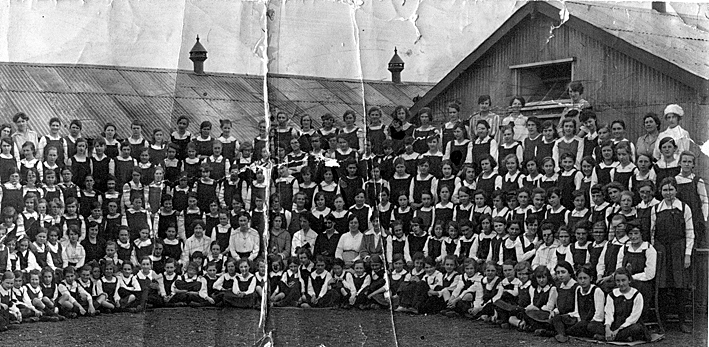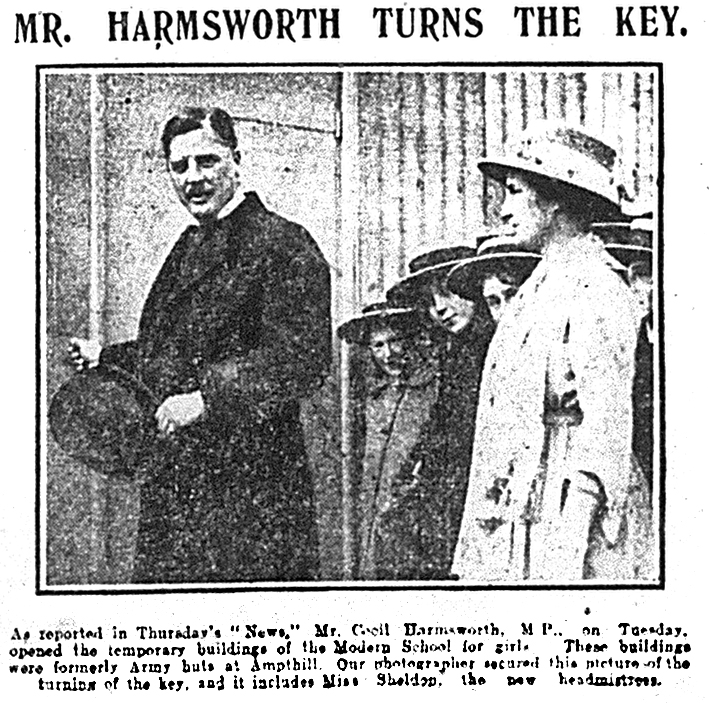
- First pupils of Luton Girls Modern School and huts in which the school was initially housed.
[The Luton News: Thursday, October 2nd, 1919]
Tuesday [September 30th] was an important milestone in the progress of Luton Modern School. It marked the separation of the Boys' School from that of the girls, who will now be educated in temporary buildings at Alexandra Avenue, Wardown.
Before the war the Governors decided on a fine new school for the girls which would be an acquisition for the town, but the war intervened and, although the plans were made and adopted, the scheme had to be postponed. In the meantime the existing accommodation of the school of Park Square became totally inadequate, and some months ago the Governors bought several corrugated iron buildings which had housed the soldiers at Ampthill.
They were brought to Luton, and have since been converted into a building which should temporarily prove very satisfactory until building conditions are more favourable. There are four main buildings connected by corridors and, if not too prepossessing from the exterior, they are highly efficient and weather-proof.
 The opening ceremony was performed on Tuesday by Mr Cecil Harmsworth MP, in the presence of a large and representative assembly of the school girls, parents and prominent citizens.
The opening ceremony was performed on Tuesday by Mr Cecil Harmsworth MP, in the presence of a large and representative assembly of the school girls, parents and prominent citizens.
The speeches were made in the Modern School, Park Square, the large hall being filled by the audience. Alderman H. O. Williams (Chairman of the Governors) presided, and on the platform were Mrs Carruthers, Mrs Walmsley (Bedford), Mrs Slatter, Miss Sheldon (the new headmistress), Alderman H. Arnold, Councillors W. J. Primett and George Warren, Mr Barnes (Director of Education), Mr Sanderson (headmaster) and Mr Smart (County Surveyor).
The Chairman expressed pleasure at seeing so many present, and said this was the turning-point in the history of the school. Fourteen years ago it was started, not necessarily with the idea of it being a mixed school, but with the idea of separating the departments. At the time it was a vanture, but through the great held of their old friend, Lord Ernie (Mr Prothero), and with the support of Mr Whitbread, Chairman of the County Education Committee, the school was started with a good impetus.
It had been successful ever since, and before the war it had been determined to separate the departments, and build the girls' school at the other end of the town. This had to be postponed, but the school had increased to the extent of being overcrowded to the number of 80 scholars during the last 12 months.
It became imperative to do something, but owing to the huge cost of building it was impossible to erect the new permanent school which they could look forward to with hope of its being an ornament to the town and of great advantage to the school itself.
At considerable cost they secured the military huts, and they had turned out to be very suitable. They were practically ready for the opening of the school, although it was only 3½ months since the contract was signed. They were not so attractive outside, but were very good inside.
Miss Sheldon, the new headmistress, came to them with very high qualifications, great experience and very good credentials, and the parents could entrust their girls to her with great confidence.
The buildings were merely the shell of the school, which was itself a living organisation, with teaching by precept and example, discipline and esprit de corps. It would be a real centre of education.
The school motto was “Where the seed is sown, there you will find the harvest”. Mr Sanderson had been sowing the seeds for 14 years both for girls and boys, and already there had been a harvest. Now Miss Sheldon would carry on the good work of sowing.
The Chairman welcomed Mr Harmsworth, especially in view of the fact that he had to get from the Isle of Wight under great difficulties. He also thanked the Bedford friends for coming despite the unfortunate rail strike. In the town itself they had not yet begun to fee the effects of the strike, but it was difficult to travel long distances.
Mr Harmsworth, who was heartily received, said it was a pleasure to a Member of Parliament to find himself now and again in an atmosphere devoid of controversy. In considering the project starting that day they were on common ground. It must be a first principle with all that anything which could be done to promote education in the country should make them all join hands in assisting.
He often thought that the greatest undeveloped estate we had in the country was the brains of the growing generation, It was beyond calculation what a great country might achieve if a fair chance were given to all the young people in the country to make the best use of the talent which Providence had given them.
It was a pleasure to know that in Luton they were taking a further and most important step forward in the direction of higher education. He trusted the parents of the community would do their best, even undergoing the greater sacrifices, to keep the boys and girls longer at school.
The new headmistress – who they all wished a prosperous and profitable career – would agree that if they were taken from the school when they were 14, or even 16, they would not have achieved their present distinct academic success. He (Mr Harmsworth) could not say that at the age of 14 he was educationally qualified for any position whatever, and at the age of 16 he could not be regarded as anything like equipped for the battle of life.
He would like to think of the Modern School as one of the rungs of the ladder to the university. In this constituency he had said nothing with greater confidence than that he should like to see a pathway open free to every child to the highest form of education the country could supply.
The question of education lay deeply at his heart, and he rejoiced to think that in Bedfordshire and in Luton there were people of wide public spirit who were never content with the system they found, but were striving for improvement.
Mr Sanderson, speaking briefly, said he felt like the bride's father. He had to give the girls away to Miss Sheldon. He wanted to pay a tribute to what the girls had done in the past. Up to the end of last term there were 1,448 children on the books, including 818 boys and 630 girls. They would notice the number of boys had always been considerably great than the girls, and yet, as far as the success in examinations went, the girls had certainly more than their share. Therefore, he boys' school had something to face.
Miss Sheldon, who was warmly received, gave an eloquent address, and said she felt it an honour to be headmistress, especially as so many of the girls came from such a good school already. That would make her task easier.
They were going to try and make the school a good one, and there were many factors in doing o. One of the chief was the attainment of a very fine spirit of esprit de corps which would make them put the good of all before individual benefit.
She pleaded with the parents to co-operate with them, for without that help all the good done for a girl was neutralised. To get the best out of anything the best must be put in, and in order to gain one must give.
Miss Sheldon called for equal enthusiasm both in the scholastic and the athletic and social spheres, for these were closely linked. She asked the parents to let the girls join all or most of the school societies. If a girl was fond of school she was likely to be a good citizen, for the school was the preparation for life. She made a stirring call to parents, the staff and the girls for loyalty and enthusiasm, so that the school would be one of the best pieces of good fortune for Luton.
Alderman Arnold proposed a vote of thanks, seconded by Mrs Slatter, who said that mothers of Luton knew this school had been needed for years. The girls would find Miss Sheldon a guide, philosopher and friend.
Afterwards the party went by special trams and other vehicles to the new buildings, where Mr Harmsworth formally turned the key to perform the opening ceremony. The buildings were then inspected, the plans for the new school being exhibited on the walls.
[The Duchess of Atholl opened the permanent building on November 5th, 1930.]

